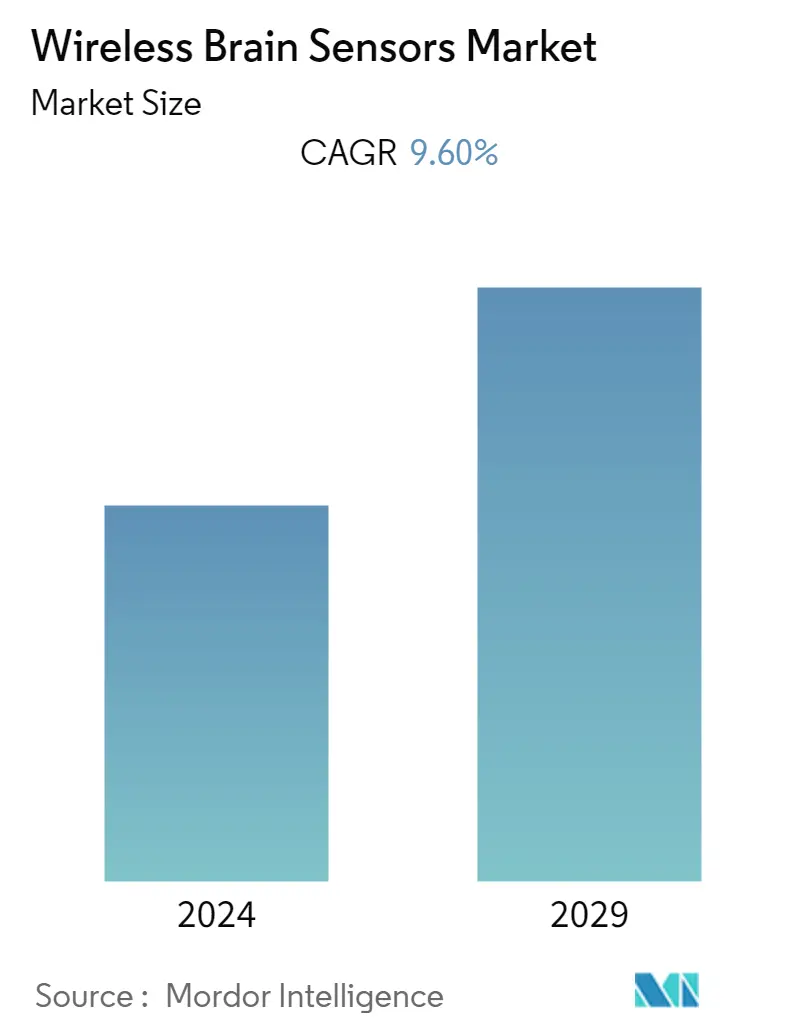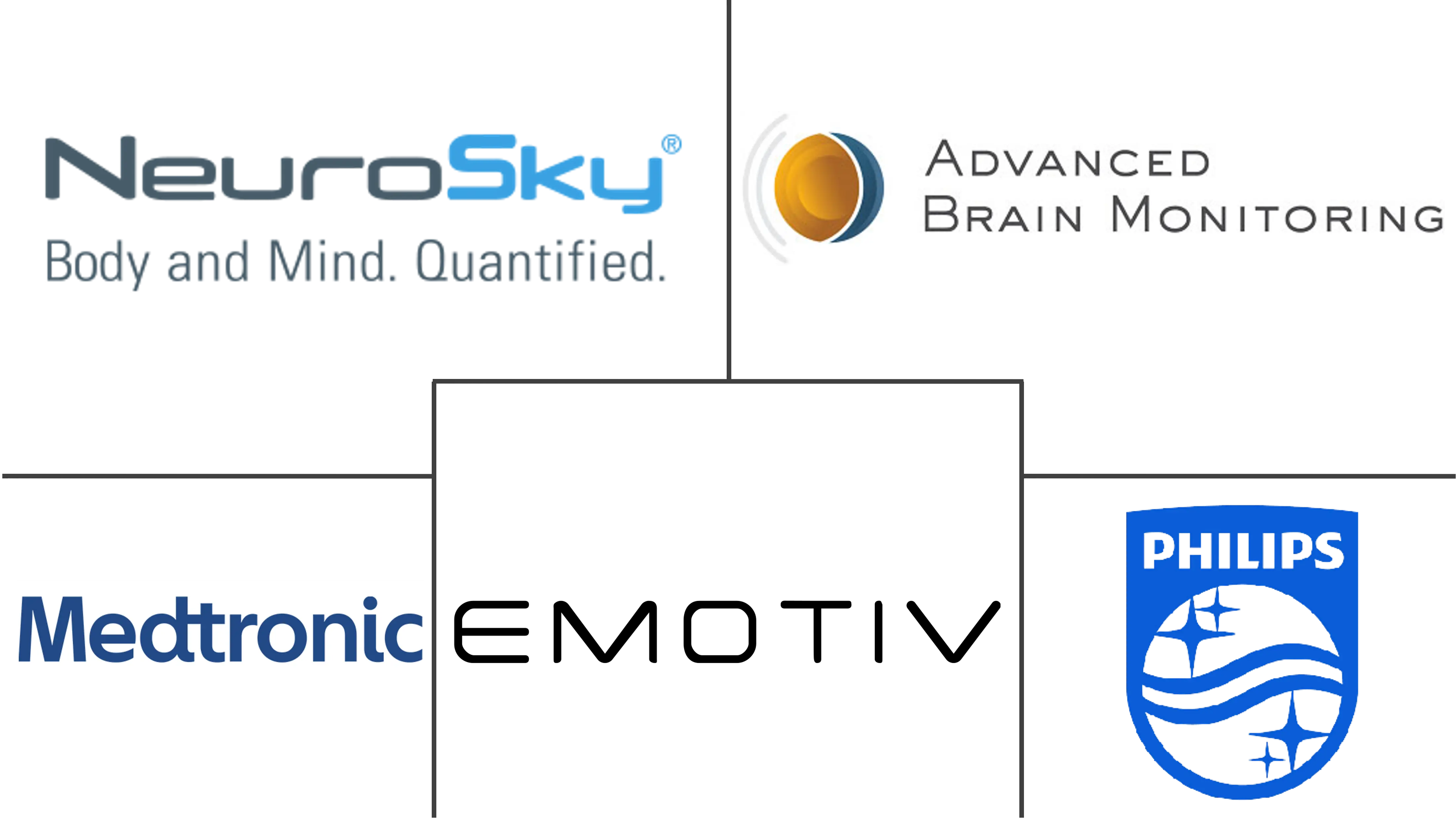Market Size of Wireless Brain Sensors Industry

| Study Period | 2019 - 2029 |
| Base Year For Estimation | 2023 |
| CAGR | 9.60 % |
| Fastest Growing Market | Asia-Pacific |
| Largest Market | North America |
| Market Concentration | Low |
Major Players
*Disclaimer: Major Players sorted in no particular order |
Wireless Brain Sensors Market Analysis
The wireless brain sensors market is projected to register a CAGR of 9.6% during the forecast period.
The COVID-19 pandemic significantly impacted the wireless brain sensors market during its early phase, as many individuals had sleep difficulties and related brain problems. However, the market has been recovering since restrictions were lifted. The prevalence of neurological disorders, new product launches, and increasing demand for brain sensors have led the market over the last two years.
The primary factor contributing to the market's growth is the rising prevalence of neurological disorders such as Parkinson's disease, epilepsy, and Alzheimer's disease. Numerous factors, such as lifestyle changes and severe social environment variations, have collectively strengthened the demand for wireless brain sensors. For instance, as per an Alzheimer's Association report, an estimated 6.5 million Americans aged 65 and above are living with Alzheimer's. Of that population, 73% are aged 75 or above. According to the same source, the prevalence of Alzheimer's disease is increasing due to the growing geriatric population. By 2050, the number of people aged 65 and older with Alzheimer's is projected to increase to 12.7 million, barring medical breakthroughs to prevent, slow, or cure Alzheimer's disease. Hence, people may adopt wireless brain sensors to improve their quality of life, thereby boosting the market's growth.
There are over 10 million new cases of dementia each year worldwide, implying one new case every 3.2 seconds. Furthermore, the rising investments in research and development and technological advancements boost the market's growth. For instance, in January 2022, iMediSync, an AI-driven early detection and therapeutic platform for optimal brain health from Seoul, South Korea, showcased its comprehensive EEG solution (hardware + software + remote telehealth solution) to perform brain mental health screening and predictive analysis of potential mental conditions in just 10 minutes. It launched its first therapeutic device at the 2022 CES Las Vegas, iSyncWave, which integrates both EEG brain mapping and LED therapy.
Hence, owing to the above-mentioned factors, the wireless brain sensors market is likely to grow over the forecast period. However, stringent regulations and the complexity of the functionality of the product are likely to restrain the growth of the market studied.
Wireless Brain Sensors Industry Segmentation
Wireless brain sensors are devices that help to observe the temperature, sense intracranial pressure, and record brain signaling in the form of brain waves. The essential aim of this wireless brain sensor is to secure the person from emergency situations. The devices are mainly used for patients suffering from sleep disorders, traumatic brain injury, dementia, Parkinson's disease, and other neurological conditions.
The wireless brain sensors market is segmented by product type (devices and accessories), application (traumatic brain injuries, dementia, sleep disorders, and other applications), and geography (North America, Europe, Asia-Pacific, South America, and Middle East and Africa). The report also covers the estimated market sizes and trends for 17 countries across major regions globally. The report offers values in USD million for all the above-mentioned segments.
| By Product Type | |||||
| |||||
| Accessories |
| By Application | |
| Traumatic Brain Injuries | |
| Dementia | |
| Sleep Disorders | |
| Other Applications |
| By Geography | ||||||||
| ||||||||
| ||||||||
| ||||||||
| ||||||||
|
Wireless Brain Sensors Market Size Summary
The wireless brain sensors market is experiencing significant growth, driven by the increasing prevalence of neurological disorders such as Parkinson's, epilepsy, and Alzheimer's disease. The demand for these sensors has been bolstered by lifestyle changes and the growing geriatric population, which is more susceptible to such conditions. The market has shown resilience and recovery post-COVID-19, with new product launches and technological advancements further propelling its expansion. Innovations like iMediSync's comprehensive EEG solution highlight the sector's commitment to enhancing brain health monitoring and predictive analysis. However, the market faces challenges from stringent regulations and the complex functionality of these devices, which could potentially hinder growth.
North America is poised to dominate the wireless brain sensors market, supported by a high incidence of neurological diseases and advancements in research. The region's growth is further fueled by the increasing approval of products by regulatory bodies like the US FDA and the introduction of innovative devices by key players. The market's competitive landscape is characterized by strategic moves such as product advancements, acquisitions, and mergers, with companies like NeuroSky, EMOTIV, and Medtronic leading the charge. Additionally, the traumatic brain injury segment is expected to grow due to rising awareness and research initiatives, underscoring the market's potential for continued expansion over the forecast period.
Wireless Brain Sensors Market Size - Table of Contents
-
1. MARKET DYNAMICS
-
1.1 Market Overview
-
1.2 Market Drivers
-
1.2.1 Increasing Prevalence of Neurological Disorders
-
1.2.2 Increasing R&D Investment and Technological Advancements
-
-
1.3 Market Restraints
-
1.3.1 Stringent Regulation and Complexity of the Product
-
-
1.4 Porter's Five Force Analysis
-
1.4.1 Threat of New Entrants
-
1.4.2 Bargaining Power of Buyers/Consumers
-
1.4.3 Bargaining Power of Suppliers
-
1.4.4 Threat of Substitute Products
-
1.4.5 Intensity of Competitive Rivalry
-
-
-
2. MARKET SEGMENTATION (Market Size by Value - USD million)
-
2.1 By Product Type
-
2.1.1 Devices
-
2.1.1.1 Electroencephalography Devices
-
2.1.1.2 Sleep Monitoring Devices
-
2.1.1.3 Other Devices
-
-
2.1.2 Accessories
-
-
2.2 By Application
-
2.2.1 Traumatic Brain Injuries
-
2.2.2 Dementia
-
2.2.3 Sleep Disorders
-
2.2.4 Other Applications
-
-
2.3 By Geography
-
2.3.1 North America
-
2.3.1.1 United States
-
2.3.1.2 Canada
-
2.3.1.3 Mexico
-
-
2.3.2 Europe
-
2.3.2.1 Germany
-
2.3.2.2 United Kingdom
-
2.3.2.3 France
-
2.3.2.4 Italy
-
2.3.2.5 Spain
-
2.3.2.6 Rest of Europe
-
-
2.3.3 Asia-Pacific
-
2.3.3.1 China
-
2.3.3.2 Japan
-
2.3.3.3 India
-
2.3.3.4 Australia
-
2.3.3.5 South Korea
-
2.3.3.6 Rest of Asia-Pacific
-
-
2.3.4 Middle East and Africa
-
2.3.4.1 GCC
-
2.3.4.2 South Africa
-
2.3.4.3 Rest of Middle East and Africa
-
-
2.3.5 South America
-
2.3.5.1 Brazil
-
2.3.5.2 Argentina
-
2.3.5.3 Rest of South America
-
-
-
Wireless Brain Sensors Market Size FAQs
What is the current Wireless Brain Sensors Market size?
The Wireless Brain Sensors Market is projected to register a CAGR of 9.60% during the forecast period (2024-2029)
Who are the key players in Wireless Brain Sensors Market?
NeuroSky, EMOTIV, Advanced Brain Monitoring, Inc., Koninklijke Philips N.V. and Medtronic are the major companies operating in the Wireless Brain Sensors Market.

